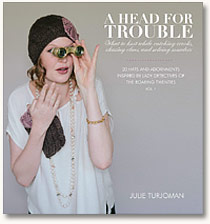Knit something special for your inner flapper!
Pre-order promotions start on October 15, so stay tuned!

Just in time for holiday gift-knitting, A Head For Trouble is nearly ready to launch! It has been really, really hard to keep this big project a secret, but the wait is nearly over. In fact, the pattern basics are now up on Ravelry, so you can decide which to knit first.
I hope you’ll feel moved to pull out your treasured skeins of luxury yarn, and work up some of these special designs.
I got a few advance copies of the book last week, and couldn’t be more excited about the way it turned out.

The theme is quirky, I know. But how better to combine my passion for 1920s fashion with my love of literary mysteries that feature strong female crime-busters?
As a knitwear designer, nothing gets my creativity more fired up than a challenge like the one I set for myself with A Head For Trouble.

For all of us who adore Downton Abbey and similar period TV shows, we know that it’s the fabulous fashions as much as the compelling story lines that keep us tuning in week after week, and season after season.
And again, as a knitwear designer with a penchant for period fashion, it was a thrill to set myself the task of interpreting the Roaring Twenties for today’s knitter.
![]()

The 1920s was a time of unprecedented change for women. Also known as the “between the wars” period because WWI had ended and WWII was not yet even a distant rumble on the horizon, in the 1920s women enjoyed freedoms that had previously been exclusive to men.
Without getting too lecture-y here (but I do love history!), for the first time women were holding jobs in traditionally male professions. They owned and drove their own automobiles. They sought higher education in greater numbers, and the right to vote became a lightening rod issue of the day.

We see all of these forces at work in period dramas like Downton Abbey, and fashion was perhaps the most visible manifestation of the new freedoms that women demanded.
No more corsets, bustles, or “dressing” one’s hair into an elaborate coiffure. Skirts were shortened and tops became loose and drapey to allow for freedom of movement. Women bobbed their hair into a short, manageable style known as a “shingle,” or an “Eton crop.” These new hair styles necessitated new hat styles to complement them, and that’s where A Head For Trouble comes in.

As you’ll soon see, A Head For Trouble includes all the hat styles popular during the Jazz Age, along with the most important accessories to accompany them. And I can hardly wait to share them with you.




Comments welcome